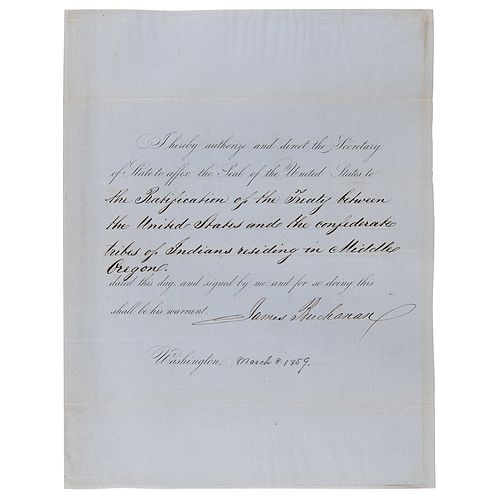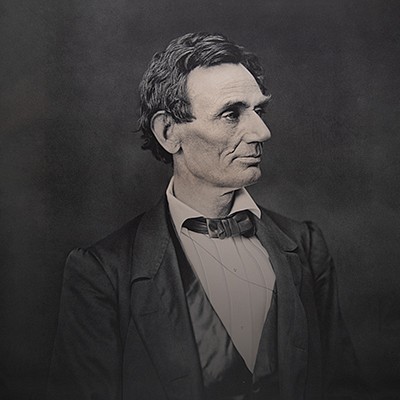President James Buchanan Ratifies a Treaty with the Tribes of Middle Oregon
Two ways to bid:
- Leave a max absentee bid and the platform will bid on your behalf up to your maximum bid during the live auction.
- Bid live during the auction and your bids will be submitted real-time to the auctioneer.
Bid Increments
| Price | Bid Increment |
|---|---|
| $0 | $5 |
| $50 | $10 |
| $200 | $25 |
| $500 | $50 |
About Auction
Feb 14, 2024
RR Auction's February Fine Autographs and Artifacts auction boasts 600 unique items, and honors Presidents' Day with a special section featuring incredible presidential autographs, artifacts, and memorabilia. RR Auction support@rrauction.com
- Lot Description
Partly-printed DS as president, one page, 8 x 10.5, March 8, 1859. President Buchanan directs the Secretary of State to “affix the Seal of the United States to the Ratification of the Treaty between the United States and the confederate tribes of Indians residing in Middle Oregon.” Signed neatly at the conclusion by James Buchanan. The document is affixed by its left edge inside a presentation folder that also contains a printed copy of the ‘Treaty with Tribes of Middle Oregon, 1855.’ In fine condition, with light toning and wrinkling.
Per the Oregon History Project: ‘In June 1855, Joel Palmer, Oregon Superintendent of Indian Affairs, met at The Dalles with representatives of the various Upper Chinookan and Sahaptin peoples of the mid-Columbia River in order to negotiate a treaty between them and the United States. These groups included the Tygh, Wyam, Tenino, and Dock-Spus bands of the Walla Walla, and the Dog River, Dalles, and Ki-Gal-Twal-La bands of the Wasco. In the final agreement, titled the Treaty with the Tribes of Middle Oregon, these groups ceded to the U.S. government approximately 10 million acres of land south of the Columbia River between the Cascade and Blue Mountain ranges. The groups that became the Confederated Tribes of the Warm Springs Reservation also reserved 578,000 acres south of the Columbia on the Deschutes, Warm Springs, and Metolius rivers for their exclusive use. The treaty also preserved the groups’ traditional practices of traveling to various off-reservation sites for fishing, hunting, and gathering.
The treaty proposed by Palmer was advantageous to the U.S. government because it largely removed the Upper Chinookan and Sahaptin peoples from the Columbia River corridor. The river was destined to become a major east-west route connecting the Pacific slope and the western valleys to the inland regions of the Pacific Northwest. The land that the Warm Springs tribes reserved for their own use was a remote corner of their territory. Mark, a Wasco elder, is quoted as telling Palmer: ‘The place you have mentioned, I have not seen. There [are] no Indians or Whites there yet, and that is the reason I say I know nothing about that country. If there were Whites and Indians there then I would think it was a good country.’ The tribal members themselves did not perceive the reserved land as ‘real estate’ — as a commodity to be bought and sold.
After the treaty was ratified in 1859, the tribes moved onto the reservation but continued to fish at Celilo and travel throughout the upper Deschutes country for hunting, gathering, trading, and visiting distant friends and relations. In September 1912, Alberta McCabe described groups from Warm Springs near Sisters: ‘The Indians are thick everywhere you go. Parties of them camp by our ditch here nearly every night. Some of them look very prosperous and all are gaudily dressed. They have so many horses, ten or twelve extra ones with each crowd.’
In the years after the signing of the 1855 treaty, there were several infringements on the original understanding that constituted bad faith on the part of the federal government. The first of these was the so-called Huntington Treaty of 1865, which ostensibly limited tribal members’ freedom of movement off the Warm Springs Reservation. As the 1969 Belloni decision and subsequent court decisions have held, the terms of the 1865 treaty were not legal and they were not honored in practice. The second and more serious was the Dawes Act, passed by Congress in 1887. This legislation sought to commodify the Indian reservations in the United States, transforming the land into ordinary real estate by allotting individuals separate tracts. After 25 years of residence, the allottee would receive a title in fee simple and could sell the land. The Dawes Act devastated the smaller reservations in Oregon, including the Grande Ronde and Siletz reservations on the coast. The larger reservations fared better. On the Warm Springs and Klamath reservations, the necessary government surveys of the land took more than 15 years to complete. Because the number of potential allotments far exceeded the number of tribal members, relatively little land went into allotments — only 20 percent on Warm Springs — and very few allotments reached title status. As a consequence, few allotments were ever sold. The Wheeler-Howard Act repealed the Dawes Act in 1934.’ - Shipping Info
-
Bidder is liable for shipping and handling and providing accurate information as to shipping or delivery locations and arranging for such. RR Auction is unable to combine purchases from other auctions or affiliates into one package for shipping purposes. Lots won will be shipped in a commercially reasonable time after payment in good funds for the merchandise and the shipping fees are received or credit extended, except when third-party shipment occurs. Bidder agrees that service and handling charges related to shipping items which are not pre-paid may be charged to a credit card on file with RR Auction. Successful international Bidders shall provide written shipping instructions, including specified Customs declarations, to RR Auction for any lots to be delivered outside of the United States. NOTE: Declaration value shall be the item’(s) hammer price and RR Auction shall use the correct harmonized code for the lot. Domestic Bidders on lots designated for third-party shipment must designate the common carrier, accept risk of loss, and prepay shipping costs.
-
- Buyer's Premium



 EUR
EUR CAD
CAD AUD
AUD GBP
GBP MXN
MXN HKD
HKD CNY
CNY MYR
MYR SEK
SEK SGD
SGD CHF
CHF THB
THB




